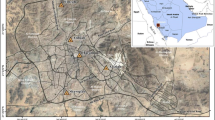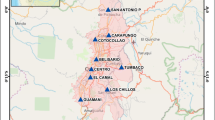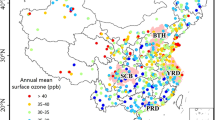Abstract
The pollution levels in New Delhi from industrial, residential, and transportation sources are continuously growing. As one of the major pollutants, ground-level ozone is responsible for various adverse effects on both humans and foliage. The present study aims to predict daily ground-level ozone concentration maxima over a site situated in New Delhi through neural networks (NN) and multiple-regression (MR) analysis. Although these methodologies are case and site specific, they are being developed and used widely. Therefore, to test these methodologies for New Delhi where no such study is available for ground-level ozone, six models have been developed based on NNs and MR using the same input data set. The changes in the performance capability of the two methods are sensitive to the selection of input parameters. The results are encouraging, and remarkable improvements in the performance of the models have been observed.
Similar content being viewed by others
References
Box, G. E. P., & Jenkins, G. M. (1976). Time series analysis: Forecast- networks and robust time series prediction. San Francisco: IEEE Transactioning and Control, Holden-Day.
Comrie, A. (1997). Comparing neural networks and regression models for ozone forecasting. Journal of the Air & Waste Management Association, 47, 653–663.
Eder, B. K., Davis, J. M., & Bloomfield, P. (1994). An automated classification scheme designed to better elucidate the dependence of ozone on meteorology. Journal of Applied Meteorology, 33, 1182–1199.
Elkamel, A., Abdul-Wahab, S., Bouhamra, W., & Alper, E. (2001). Measurement and prediction of ozone levels around a heavily industrialized area: A neural network approach. Advances in Environmental Research, 5, 47–59.
Gardner, M. W., & Dorling, S. R. (1998). Artificial neural networks (the multilayer perceptron)—A review of applications in the atmospheric sciences. Atmospheric Environment, 32, 2627–2636.
Gardner, M. W., & Dorling, S. R. (2000). Statistical surface ozone model: An improved methodology to account for non-linear behaviour. Atmospheric Environment, 34, 21–34.
Hill, T., Marquez, L., O’Connor, M., & Remus, W. (1994). Artificial neural networks for forecasting and decision making. International Journal of Forecasting, 10, 5–15.
Hubbard, M. C., & Cobourn, W. G. (1998). Development of a regression model to forecast ground-level ozone concentrations in Louisville, KY. Atmospheric Environment, 32, 2637–2647.
Marquez, L., Hill, T., O’Connor, M., & Remus, W. (1992). Neural network models for forecast a review. In IEEE proceedings of the 25th Hawaii international conference on system sciences (pp. 494–498).
Narasimhan, R., Keller, J., Subramaniam, G., Raasch, E., Croley, B., Duncan, K., et al. (2000). Ozone modeling using neural networks. Journal of Applied Meteorology, 39, 291–296.
National Research Council (1991). Rethinking the ozone problem in urban and regional air pollution.Washington, DC: National Academy of Sciences, National Academy Press.
Robeson, S. M., & Steyn, D. G. (1990). Evaluation and comparison of statistical forecast models for daily maximum ozone concentrations. Atmospheric Environment, 2, 303–312.
Ryan, W. F. (1995). Forecasting severe ozone episodes in the Baltimore metropolitan area. Atmospheric Environment, 29, 2387–2398.
Scheifinger, H., Stohl, A., Kromp-Kolb, H., & Spangl, W. (1996). A statistical method for predicting daily maximum ozone concentrations. Gefahrstoffe, Reainhaltung der Luft, 56, 133–137.
Sousa, S., Martins, F., Alvim-Ferraz, M., & Pereira, M. (2007). Multiple linear regression and artificial neural networks based on principle components to predict ozone concentrations. Environmental Modelling and Software, 22(1), 97–103.
USEPA (1999) Guideline for developing an ozone forecasting program, EPA-454/R-99-009. Research Triangle Park, NC 27711: Office ofAir Quality Planning and Standards.
van Aalst, R., & de Leeuw, F. (1997). National ozone forecasting systems and international data exchange in northwest Europe. EEA Tech. Report, No. 9; 50.
Willmott, C. (1982). Some comments on the evaluation of the model performance. Bulletin of the American Meteorological Society, 63(11), 1309–1313.
Willmott, C., Ackleson, S., Davis, R., Feddema, J., Klink, K., Legates, D., et al. (1985). Statistics for the evaluation and comparison of models. Journal of Geophysical Research, 90(C5), 8995–9005.
Yi, J., & Prybutok, V. R. (1996). A neural network model forecasting for prediction of daily maximum ozone concentration in an industrialized urban area. Environmental Pollution, 92(3), 349–357.
Author information
Authors and Affiliations
Corresponding author
Rights and permissions
About this article
Cite this article
Mahapatra, A. Prediction of daily ground-level ozone concentration maxima over New Delhi. Environ Monit Assess 170, 159–170 (2010). https://doi.org/10.1007/s10661-009-1223-z
Received:
Accepted:
Published:
Issue Date:
DOI: https://doi.org/10.1007/s10661-009-1223-z




